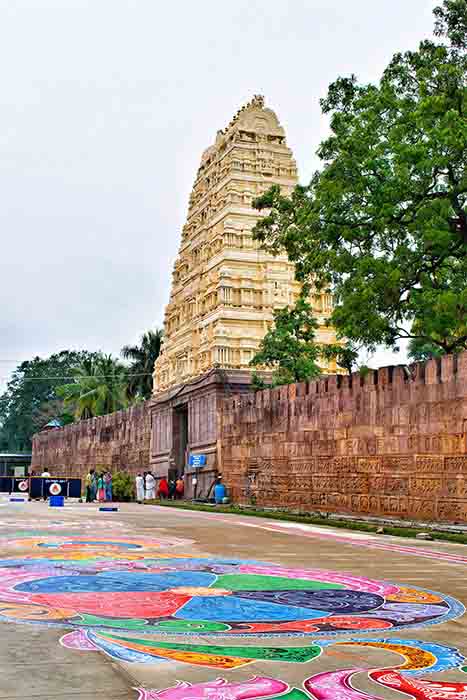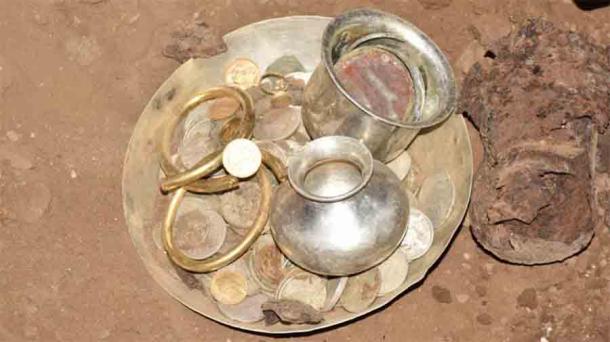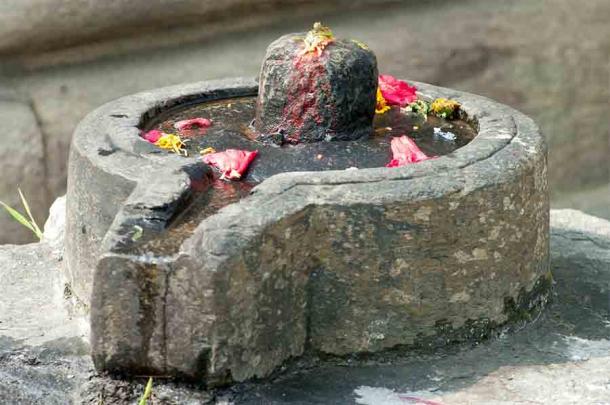
Rare Inscribed Medieval Era Copper Plates Found at Srisailam Temple
Recently, a fabulous discovery was made that has greatly enriched the history of an already vibrant temple. Twenty-one medieval era copper plates have been unearthed by the Srisailam authorities at the Mallikarjuna Temple in India, which are dated to the 16th century, or even earlier. The plates were inscribed in the subcontinental languages of Sanskrit, Kannada and Telugu.

The entrance to the Shiva-devoted Mallikarjuna Temple in Srisailam, Andhra Pradesh, India. (Arpita Tripathy / CC BY-SA 4.0)
The Last Few Months Have Yielded Many Artifacts at Srisailam
Six sets of copper plates (18 leaves) were found during the course of renovation work in Ghanṭa Maṭham at Srisailam, carried out by the temple authorities. Out of 6 copper plate sets, 4 sets are written in Sanskrit language and Nandi-Nāgarī script, and the other 2 plates are in the Telugu language, although they are yet to be deciphered. “All the plates can be assigned between 14th-16th century CE [AD],” said Chenna Reddy, Dean of Archaeology at Telugu University Campus and Director of Archaeology and Museums, in The Deccan Chronicle.
And that’s not all. This is the third of a recent spate of such discoveries over the last few years!
In October, 2020 a brass box was discovered the ancient Ghanta Matham, which contained 15 British-era gold coins, 18 silver coins and a gold ring at, as per a report by The Hindu. Srisailam Publications Editor Anil Kumar said in a release that the gold coins were minted between 1880 and 1911, while the silver coins were minted between 1885 and 1913, and another silver coin found separately was minted in 1892.
- Deep Mining the Mythology of Ganesha and the Ancient Temple Well
- Ancient caves depicting 7000-year-old civilisation and culture discovered in India
I 2017, a stash of treasures including 700 grams of gold ornaments, comprising three gold kadiyams weighing 525 gm, 18 gold coins and four rings. The silver component of the hoard was 147 silver coins, silver vessel weighing 395 gm and a tumbler weighing 133 gm.

Ornaments, silver vessels and coins found at the Ghanta Matham in Srisailam in 2017. (Deccan Chronicle)
History of the Srisailam Mallikarjuna Temple
Mallikarjuna Temple in Srisailam in the southern Indian state of Andhra Pradesh is dedicated to the deity Shiva, one of the most popular and highly worshipped gods from the Hindu pantheon. It has received patronage from royal kings and empires, particularly during the medieval era, including the Kondavidu Reddi kingdom (1325-1448 AD), Kakatiyas(1163-1323), and the famous Vijayanagara Empire (1336-1646). Inscription evidence from the time of the Satvahanas indicates that the temple has been around at least since the 2nd century AD.
The legend of the temple says that Shiva and his partner, Parvati, had their son Ganesha (the elephant god) marry Buddhi, Siddhi and Riddhi (the deities of intellect, spiritual power and prosperity, respectively). In India, it is customary to have parents choose partners for their children. Their other son, Kartikeya, was enraged at being denied the same level of affection by his parents and went away alone to stay on a mountain top.
His parents, particularly Shiva, came to pacify him and where they stayed was a place called Srisailam. Incidentally, another Shiva legend places him as an endless pillar of light, worshipped in the form of a phallus, or the jyotirlinga. Shiva appeared in 64 of these jyotirlingas in his different forms, avatars or rebirths, of which 12 are considered auspicious and holy. Mallikarjuna Temple is one of these 12 jyotirlingas, getting its name from the worship of the jasmine flower or Mallika.

A Shiva lingam is probably the most common symbol of Shaivism. The Shiva representation in this photo is the erect stone column in the middle, surrounded by what is held as the ‘yoni’ or female genitalia. (viktorov.pro / Adobe Stock)
Shiva and Phallocentric Worship in the Hindu Faith
In Shaivism, a huge denomination of the Hindu faith, the representation of Lord Shiva is through the linga or lingam, an iconic form. The linga is a phallic representation of Shiva, particularly alluding to the spiritual understanding of fertility and cosmic regeneration. It holds a pious and special place in the Hindu faith, being used in all forms of Shiva related worship.
- Villagers Unearth Indian Temple Buried in River Sand
- Draksharama Temple, Where Dozens of Hindu Gods Live as a Family
In faiths across the world, including ancient Egypt and Greece, the phallus has been used in differing contexts but universally signifies the male sexual organ, fertility, and the male orgasm. Even in India, evidence of phallic worship has been found in several ancient Indus Valley sites, showing that it was prevalent as a magical rite from the Chalcolithic period onward.
With the development of religion in India, the linga was shown with the yoni, the female sexual organ, who together represented the combination of microcosmos and macrocosmos. Followers of the faith deny any allusions to sexual organs, instead argue that the lingam represents the birth of creative energy, and spiritual truth.
Top image: Six sets of copper plates that were discovered at the Ghanta Matham in Srisailam in June 2021. Source: The Hindu
By Rudra Bhushan
References
DC. 2021. Six set of copper plates unearthed at Srisailam temple in a rare discovery. Available at: https://www.deccanchronicle.com/nation/in-other-news/140621/six-sets-of-copper-plates-unearthed-at-srisailam-temple-in-a-rare-disc.html.
NIE. 2021. 21 copper plate inscriptions found in Srisailam. Available at: https://www.newindianexpress.com/states/andhra-pradesh/2021/jun/14/21-copper-plate-inscriptions-found-in-srisailam-2315951.















